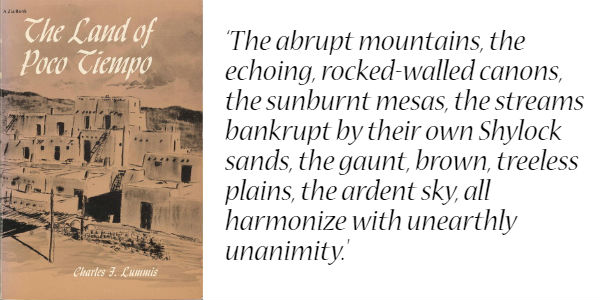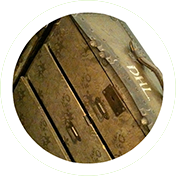
‘Lawrence! – this is the best that has been done yet – And yet if you knew what lies untouched behind these externals, unreached by the illuminating vision of a simple soul yet! Oh come!’ Inscription inside a copy of The Land of Poco Tiempo (1893) by Charles Fletcher Lummis that Mabel sent to Lawrence to entice him to Taos.
In the world of electronic media, communication is pretty easy. You type out a text, press send, and voila. But back in the 1920s things were a bit more complex. After trying the traditional route of sending a letter, Mabel Dodge Luhan (MDL), a wealthy American patron of the arts, went for a more unconventional way of luring DH Lawrence to her home in Taos, New Mexico. She willed him to come. ‘I drew myself all in to the core of my being where there is a live, plangent force lying passive…I leaped through space, joining myself to the central core of Lawrence, where he was in India, in Australia…I became the action that brought him across the sea.’

MDL was convinced that Lawrence would be able to help the Pueblo Indians by documenting their lives. Although he was keen to visit, he didn’t share her sense of urgency. Undeterred, MDL asked her husband Tony to help her. Tony Luhan was a Native American Indian who had wooed MDL by setting up a tepee in front of her house, drumming each night until she eventually succumbed to his advances. If they combined magical powers, surely Lawrence would get his arse in gear and fulfil his destiny. Tony was reluctant to use his magic at first, arguing ‘the Indians believe that utterance is loss and that the closed and unrevealed holds power’ but this wasn’t the time for passivity and so MDL, sounding a bit like a business executive, ‘overruled him’.
When Lawrence and the QB finally turned up, Tony and MDL picked them up from Lamy station, 20 miles beyond Santa Fey. The charcoal kilns were burning pinon-wood, filling the air with a smell of incense. But MDL’s descriptions of their initial encounter are far from tranquil. The claws are out immediately. Frieda is described as having ‘a mouth like a gunman’ and Lawrence ‘ran with short, quick steps at her side…his slim fragility beside Frieda’s solidity.’ He is described as ‘scurrying’ to her side, and that he ‘twitches’ as he hides ‘behind her big body’. Given she had previously bragged about controlling her own husband she doesn’t seem to enjoy other women controlling their own.
Lawrence was ‘agitated, fussy, distraught, and giggling with nervous grimaces’ whereas Frieda ‘immediately saw Tony and me sexually, visualising our relationship.’ MDL is quite perceptive here, recognising Lawrence was uncomfortable with Frieda’s overt sensuality and that he was ‘through with that’. She observes ‘Frieda was complete, but limited. Lawrence, tied to her, was incomplete and limited. Like a lively lamb tied to a solid stake.’ Ouch. Full of hubris and an unhealthy infatuation with Lawrence, MDL believes she has the transformative power ‘that succeeds primary sex…the womb behind the womb’. She can be Lawrence’s emotional and intellectual confident.

As the four set off together in the car, the tensions begin to mount. This is made worst when the car brakes. Tony knows nothing about cars, but has a look under the bonnet – perhaps willing it to work. Frieda tells Lawrence to man up and get out and fix it but instead he starts ranting about these ‘nasty, unintelligent, unreliable things’ – that being the cars, rather than women. However, in Knud Merrild’s memoir A Poet and Two Painters (1938), he recalls Lawrence eagerly jumping out of their beloved but unrealiable car ‘Lizzie’ to help fix it as ‘he couldn’t bear not to be master of the situation.’
Fortuitously, Tony manages to get the car started without the aid of a drum or magic and they head to Sante Fe. But the drama isn’t over yet. The hotels are all booked up. But Witter Bynner and Spud Johnson are ‘always up’, and they host them for the night.
The next day there was a horrendous storm. The hail ‘battering upon the top of the car like cannon balls, cracking open on the ground like splitting shells.’ Unsurprisingly, MDL finds cosmic resonance in the weather, attributing it to her new guest. Although the storm did not last long, it managed to destroy all of the crops resulting in practically no harvests taken in all that year.
When Lawrence and Frieda finally arrived at MDLs, they had food in her dimly lit home and Lawrence, appreciative as ever, commented ‘It’s like one of those nasty little temples in India!’ When talk moved to their boat journey over, Lawrence shared his horror at having to share the deck with a group of Hollywood people. ‘Lawrence made us see that ship; the long slow passage through the blue sea, the reckless, sensational crowd on board, and his own watching angry, righteous, puritanical presence among them.’
And so begins a bizarre, loving, hateful, jealous, bitchy psychodrama that would be played out over campfires, charades, horseback rides and numerous letters up in the Lobo Mountains.
Source: Mabel Dodge Luhan (1932) Lorenzo in Taos (chapter 2).

In the DH Lawrence Memory Theatre we want to address various aspects of Lawrence’s life through artefacts. How could we represent Lawrence’s time in Taos or Mabel Dodge Luhan’s quirky personality? If you have an idea about this or other artefacts you think should be included, you can submit ideas here.
Further Reading
- Lorenzo in Taos 1: Come on over to my place
- Lorenzo in Taos 3: Mabeltown
- Lorenzo in Taos 4: A Centre of Disturbance
- Lorenzo in Taos 5: The Brett
- Mabel Dodge Luhan Papers at Beinecke Library Yale (beinecke.library.yale.edu)

4 thoughts on “Lorenzo in Taos 2: I put a spell on you…”